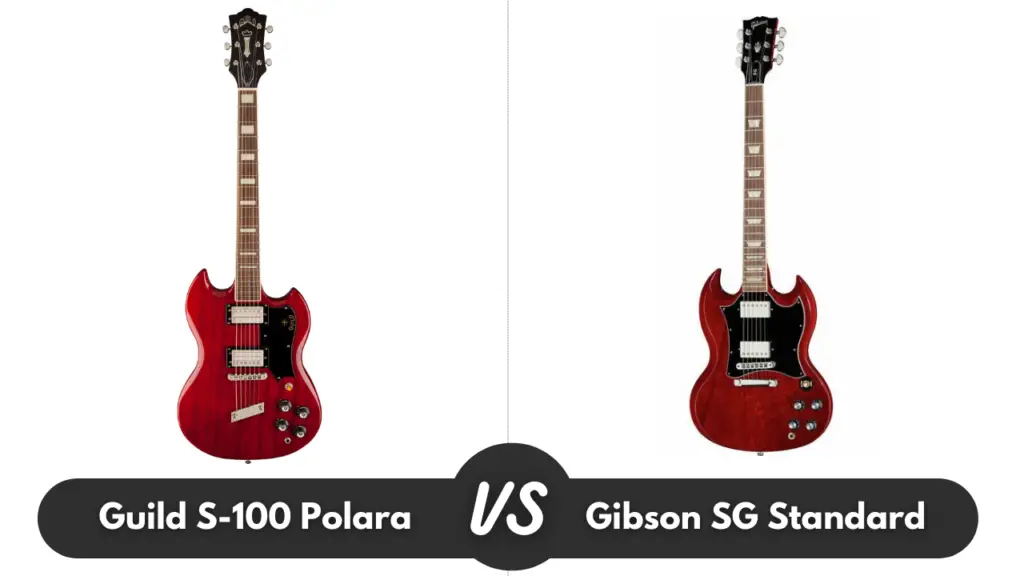Some of the best electric guitars on the market these days are the Guild Polara and the Gibson SG. Both of these guitars are loved by guitarists all over the world and have unmatched durability, sound quality, and versatility- they even look similar!
Given some of their similar appearance, they both have differences in hardware, build, and performance that sets both of these guitars apart. Learning about their differences can help you make the crucial decision of picking the best one for you.
| Features: | Guild S-100 Polara Electric | Gibson SG Standard |
|---|---|---|
| Price: | £655 | £1,499 |
| Tuners: | Grover Sta-Tite | Grover Rotomatic Tuners |
| Pickup: | 2x Guild Anti-Hum Dual-Coil | 490T |
| Frets: | 22 | 22 |
Guild S-100 Polara
Guild was rather late to the electric solidbody market, as it wasn’t until 1963 before the company released a trio: the twin pickup S-200 Thunderbird and S-100 Polara and the single pickup S-50 Jetstar.
While all three models featured asymmetrical three-a-side headstocks they borrowed from previous designs: the S-200 had a clear Jazzmaster/Jaguar style, the S-100 and S-50 a more conservative offset dual cutaway shape.
All three guitars had a concave cutaway on their bases, while the S-200 and S-100 even included built-in flip-out stands on the backs of the guitars. They lasted through the decade before Guild eventually took a more Gibson SG-like route with its 70s solidbody range.
Build
The guitar features an all-mahogany construction that’s hidden under the opaque finish, glued in the neck, and pau ferro fingerboard – the S-100 originally had a rosewood board but has since been changed.
Guild’s S-100 is Korean-made along with the rest of the Guild Newark Sts (although different factories are used for different models). Meanwhile, the S-100 model, and most Guild electrics, use a Gibson-style 629mm (24.75-inch) scale. Guild offers a choice of colours, Cherry Red translucent and solid Black and White – all with the same black pickguard and Guild logo – the cream-bound fingerboard gives a more deluxe vibe, large Pearloid block inlays and the classic dome-topped Guild head with that 70s-style solid ‘Chesterfield’ logo.
Performance
It’s no surprise that weight wise the Polara is not overdone. The neck leaves around the 20th/21st fret and, despite having quite a chunky heel, it allows for easier access to the top fret, not least with those off-set cutaways. When playing the Polara seated, it feels like its inspiration, the Gibson SG, in that the neck seems very long.
Profile-wise, Guild’s S-100 has a relaxed classic C shape. The radius of the fingerboard reveals a camber of 305mm/12 inches.
The acoustic voices are also interesting: the S-100 has a vibrancy in its voice.
The S-100 comes with a huge width of sound from the stinging big single coil-like voice at the bridge to the darker, textured neck and a sprightly and vibrant mix that give off a lot of Fender vibes.
When plugging the S-100 in, you go up a notch in juice. There’s a noticeable PAF-y quality there with a little airy chime that comes from both pickups and the mix. Its bridge has depth, it’s more humbucking although in an early sense – it’s far from overwound.
The wiring style in the S-100 plays its part as the volumes are quite sensitive – a small pull back will clean up the sound for some lovely quite single coil-like, snappy blues voices while the tones are a little more useful, certainly when the volume is near or fully up. As ever, the controls expand the voice well: a vintage-y clean bucker voice that may lack the heft of a thicker mahogany/maple-topped single-cut nevertheless sits firmly in the classic rock genre.
Gibson SG Standard
Gibson’s SG Standard has dual horns, blood red body and chrome pickup covers that remind many guitarists of some of rock’s most iconic characters. Most people are familiar with Angus Young, Tony Iommi, Frank Zappa, Pete Townsend, and even Jimi Hendrix used an SG. The simple and unique SG has drawn many in who love that raw, loud, and sometimes harsh guitar tone.
Build
Gibson’s ’57 Classic pickups are a classic rock PAF tone and perfect for the SG. Compared to the heavier Les Paul body in the Epiphone, which is over 4kg (9 lbs+), the SG on the other hand is featherweight at just under 3kg (around 6.5 lbs). This is, of course, part of the design of an SG.
For those who haven’t held Gibson’s SG before, the first thing that will strike you is that the body is very thin. It’s one of the reasons why the jack is actually in the front of the body. You’ll see the hole for the jack next to one of the tone controls.
The build quality is quite typical as it’s a top-line Gibson model. The bevelled edges, fret ends and finish are all perfect. The Tunomatic bridge and stopbar tailpiece combined with the vintage tulip tuners complete the classic look.
Performance
Many find the SG a real joy to play. Even though it still has the Gibson scale length of 629mm (24.75″), its neck feels longer. The position of the neck gives the guitar a slightly neck-heavy feel, mainly when seated.
When the strap is introduced, it balances right, but when seated, it can have a tendency for the head to drop. The overall setup in terms of action is great. This is a fairly high-end Gibson model, so you shouldn’t have any concerns in terms of frets, fret condition, edges and string action.
Gibson’s SG Standard is available in 3 colours: cherry red, ebony, classic white and a natural burst. Gibson also offers upgraded options, including the Min-ETune, which is a small device that sits snugly behind the headstock.
Conclusion
When it comes to which guitar will maintain its value, Gibson’s SG would defiantly be the better option.
